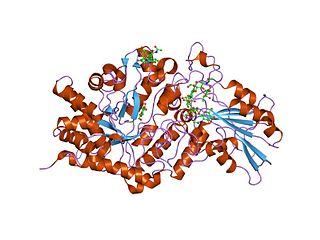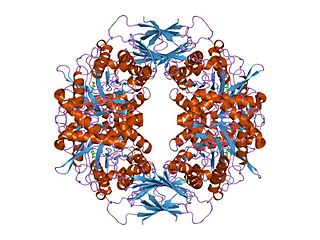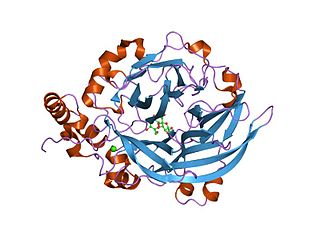| Glycosyl hydrolase family 20, catalytic domain | |||||||||
|---|---|---|---|---|---|---|---|---|---|
 wildtype streptomyces plicatus beta-hexosaminidase in complex with product (glcnac) | |||||||||
| Identifiers | |||||||||
| Symbol | Glyco_hydro_20 | ||||||||
| Pfam | PF00728 | ||||||||
| Pfam clan | CL0058 | ||||||||
| InterPro | IPR015883 | ||||||||
| SCOP2 | 1qba / SCOPe / SUPFAM | ||||||||
| CAZy | GH20 | ||||||||
| CDD | cd02742 | ||||||||
| |||||||||
| Glycosyl hydrolase family 20, domain 2 | |||||||||
|---|---|---|---|---|---|---|---|---|---|
 crystallographic structure of human beta-hexosaminidase a | |||||||||
| Identifiers | |||||||||
| Symbol | Glyco_hydro_20b | ||||||||
| Pfam | PF02838 | ||||||||
| InterPro | IPR015882 | ||||||||
| SCOP2 | 1qba / SCOPe / SUPFAM | ||||||||
| CAZy | GH20 | ||||||||
| |||||||||
In molecular biology, glycoside hydrolase family 20 is a family of glycoside hydrolases.
Glycoside hydrolases EC 3.2.1. are a widespread group of enzymes that hydrolyse the glycosidic bond between two or more carbohydrates, or between a carbohydrate and a non-carbohydrate moiety. A classification system for glycoside hydrolases, based on sequence similarity, has led to the definition of >100 different families. [1] [2] [3] This classification is available on the CAZy web site, [4] [5] and also discussed at CAZypedia, an online encyclopedia of carbohydrate active enzymes. [6] [7]
Glycoside hydrolase family 20 CAZY GH_20 comprises enzymes with several known activities; beta-hexosaminidase (EC 3.2.1.52); lacto-N-biosidase (EC 3.2.1.140). Carbonyl oxygen of the C-2 acetamido group of the substrate acts as the catalytic nucleophile/base in this family of enzymes.
In the brain and other tissues, beta-hexosaminidase A degrades GM2 gangliosides; specifically, the enzyme hydrolyses terminal non-reducing N-acetyl-D-hexosamine residues in N-acetyl-beta-D-hexosaminides. There are 3 forms of beta-hexosaminidase: hexosaminidase A is a trimer, with one alpha, one beta-A and one beta-B chain; hexosaminidase B is a tetramer of two beta-A and two beta-B chains; and hexosaminidase S is a homodimer of alpha chains. The two beta chains are derived from the cleavage of a precursor. Mutations in the beta-chain lead to Sandhoff disease, a lysosomal storage disorder characterised by accumulation of GM2 ganglioside. [8]












